Pecan pie is a delightful Southern classic that'll have you craving another slice! Originating in the 1800s, this irresistible dessert features a buttery crust, a sweet and gooey filling, and the satisfying crunch of toasted pecans. To make it, you'll whisk together eggs, corn syrup, sugar, butter, and vanilla, then pour the mixture over a bed of chopped pecans in the crust. After baking until the center is set, you'll let the pie cool completely, allowing the flavors to meld and the filling to firm up. Once you've perfected this time-honored recipe, you'll see why pecan pie is a cherished part of holiday gatherings and family celebrations.
Key Takeaways
- Pecan pie is a traditional Southern dessert that originated in the early 1800s and became a staple in holiday gatherings.
- The combination of buttery crust, sweet filling, and crunchy pecans creates an irresistible and indulgent dessert.
- The pie is made by combining pecans, corn syrup, eggs, and sugar, then pouring the mixture into a prepared pie crust.
- The pie is baked until the center is set, and then allowed to cool completely before slicing for optimal texture.
- Pecan pie is often served with whipped cream or vanilla ice cream, adding to the overall enjoyment of this beloved dessert.
History
Pecan pie has a rich history that can be traced back to the early 1800s. This beloved dessert originated in the southern United States, where pecans were abundant and commonly used in various recipes.
The first known recipe for pecan pie was published in 1886 in a Texas cookbook, but it likely existed in home kitchens long before that.
Over time, pecan pie became a quintessential part of Southern cuisine and a staple at holiday gatherings. Its popularity quickly spread throughout the country, becoming a beloved treat enjoyed by people of all ages.
The combination of a buttery, flaky crust, gooey sweet filling, and the crunchy texture of pecans creates a truly irresistible dessert.
Today, pecan pie remains a beloved classic, enjoyed by generations of Americans who cherish its rich history and delicious flavor.
Cooking Steps
Preheat your oven to 350°F.
Now, let's get started on the pecan pie! First, grab a medium-sized bowl and whisk together the eggs, corn syrup, sugar, butter, and vanilla extract until smooth and well combined.
Next, sprinkle the chopped pecans over the bottom of your prepared pie crust. Carefully pour the egg mixture over the pecans, making sure to evenly distribute them.
Pop the pie in the oven and bake for 50-60 minutes, or until the center is almost set. Keep a close eye on it, as you don't want the crust to burn.
Once it's done, let the pie cool completely on a wire rack before slicing. This allows the filling to firm up nicely.
When you're ready to serve, top each slice with a dollop of whipped cream or a scoop of vanilla ice cream for an extra special treat. Enjoy your homemade pecan pie!
Step 1. Prepare Pie Crust
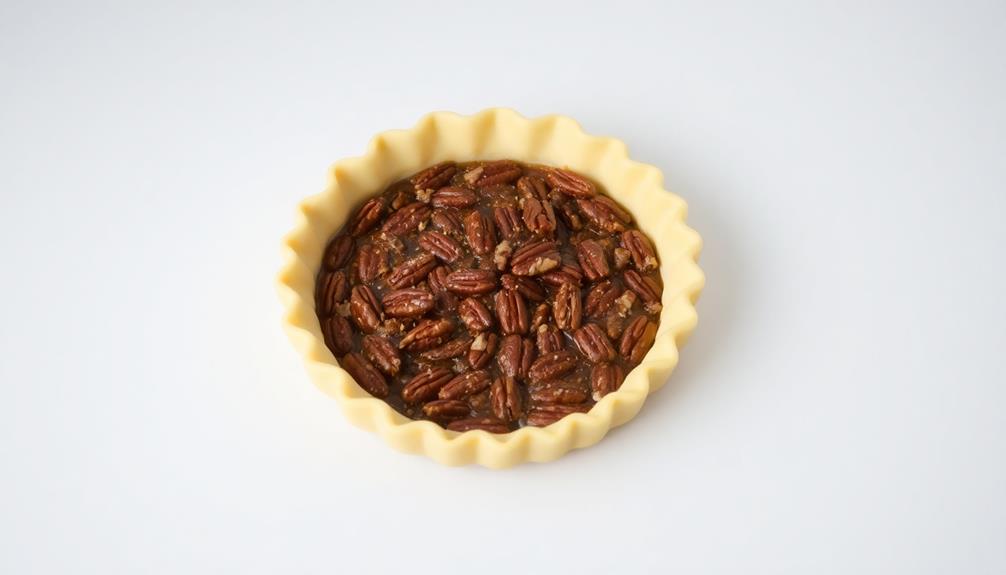
To prepare the pie crust, first gather your ingredients – all-purpose flour, unsalted butter, and ice water. In a large bowl, combine the flour and a pinch of salt. Cut the cold butter into small pieces and add them to the flour mixture. Use your fingertips to work the butter into the flour until it resembles coarse crumbs.
Next, add the ice water a tablespoon at a time, mixing gently with a fork until the dough just starts to come together. Be careful not to overmix. Gather the dough into a ball, then divide it in half. Shape each half into a disc, wrap them in plastic wrap, and refrigerate for at least 30 minutes. This chilling period is crucial to help the dough hold its shape when rolled out.
Once chilled, lightly flour a clean surface and roll out one disc of dough into a circle about 12 inches wide. Carefully transfer the dough to a 9-inch pie plate, gently pressing it into the bottom and up the sides. Trim any excess dough, then crimp the edges decoratively. Your pie crust is now ready for the filling!
Step 2. Mix Pecans, Corn Syrup, Eggs
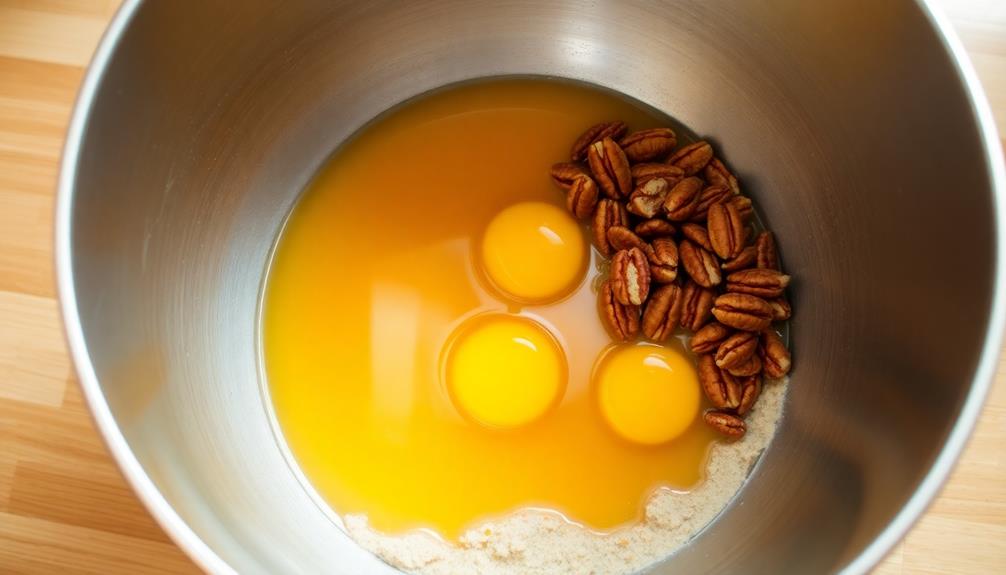
In a large bowl, combine the pecans, corn syrup, eggs, and a pinch of salt. Use a whisk to mix everything together until it's well blended and smooth. The pecans should be nicely coated in the sweet, gooey syrup.
Next, pour the filling into the prepared pie crust. Use a spatula to spread it out evenly, making sure the pecans are distributed nicely throughout.
Don't worry if the filling seems a bit runny – it'll thicken up as it bakes.
Pop the pie in the oven and let it bake until the center is set and the top is golden brown, about 40-45 minutes. Keep an eye on it towards the end to make sure the crust doesn't burn.
Once it's done, let the pie cool completely before slicing into it. This'll give the filling time to firm up nicely. Serve with a scoop of vanilla ice cream for an extra-special treat!
Step 3. Pour Filling Into Crust
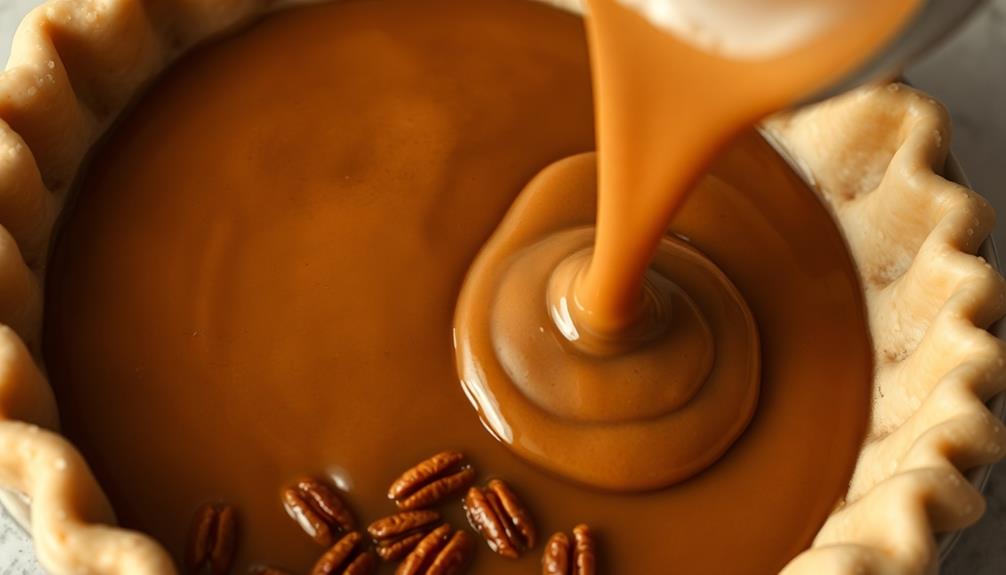
Next, pour the filling into the prepared pie crust. Be careful not to spill a single drop!
Gently pour the sweet, gooey mixture from the bowl into the flaky, golden-brown crust. You'll want to make sure the filling is evenly distributed, so give the pie a little shake to help it settle.
Once it's all in, you can smooth out the top with a spoon if needed. Now, your pecan pie is ready to bake!
Slide the filled crust into the preheated oven and let the magic happen. As it bakes, the aroma of toasted pecans and rich caramel will fill your kitchen, making your mouth water in anticipation.
Keep an eye on the pie, and when the center is just set, it's time to take it out. Be careful, as the hot filling can bubble and splatter.
Allow the pie to cool completely before slicing into it and serving. Get ready for a delicious, gooey, nutty treat!
Step 4. Bake Until Center Is Set
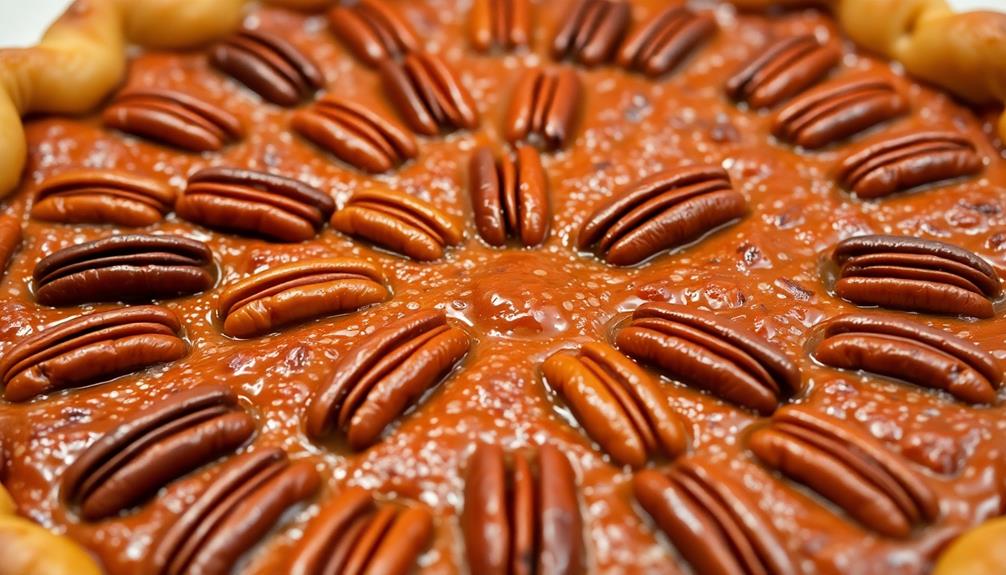
Slide the filled crust into the preheated oven and let the magic happen. Your pecan pie will need to bake for 45-55 minutes until the center is set. As it cooks, the sweet aroma will fill your kitchen, making your mouth water in anticipation.
Keep an eye on the crust, making sure it doesn't get too dark. If it starts to brown too quickly, you can cover the edges with foil to protect them. The filling should be slightly jiggly in the center when the pie is done. Don't worry if it looks a little undercooked – it will continue to set as it cools.
Once the timer goes off, carefully remove the pie from the oven. Let it cool completely on a wire rack before slicing. This allows the filling to fully set up and makes it easier to cut clean slices.
Serve your delicious pecan pie warm or at room temperature, with a scoop of vanilla ice cream on the side for an extra special treat.
Step 5. Allow to Cool Completely
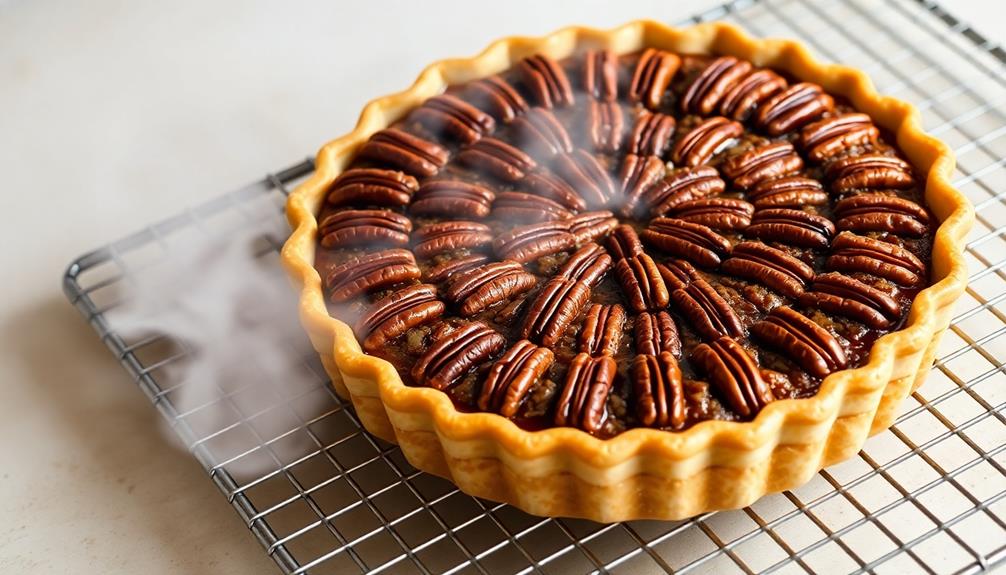
Once the pecan pie has finished baking, you'll want to let it cool completely on a wire rack before slicing. This step is crucial, as it allows the filling to set and the crust to firm up.
Be patient – it may take an hour or more for the pie to reach room temperature. Resist the temptation to dive in too soon!
As the pie cools, you'll notice the filling start to firm up and the aroma become even more delectable. This waiting game is worth it, trust us.
Once the pie is completely cool, you can slice into it with ease. The filling will hold its shape beautifully, and you'll be rewarded with that classic pecan pie texture – gooey, nutty, and irresistible.
Serve your cooled pecan pie with a dollop of whipped cream or a scoop of vanilla ice cream for an extra special treat. Enjoy every bite of this homemade masterpiece!
Final Thoughts
Though pecan pie may seem like a simple dessert, its rich, decadent flavor and time-honored tradition make it a cherished treat that transcends the ordinary.
When you take that first bite, you'll be transported to a cozy kitchen filled with the warm aroma of toasted pecans and the sweet caramelized crust. It's a dessert that sparks nostalgia and brings people together, whether it's a family gathering or a special occasion. As you savor each mouthful, you’ll find yourself reminiscing about childhood memories and creating new ones with loved ones. This pecan pie is more than just a dessert – it’s a symbol of tradition and connection. Just like a classic chili con carne recipe, it’s a dish that has the power to evoke emotions and bring people closer together.
As you savor each morsel, you'll appreciate the care and attention that went into crafting this beloved pie. From the flaky pastry to the gooey, nutty filling, every component works in harmony to create a truly remarkable experience.
And when the pie has cooled completely, you can slice into it with confidence, knowing that all your hard work has paid off.
Frequently Asked Questions
Can I Use Store-Bought Pie Crust for Pecan Pie?
Of course, you can use store-bought pie crust for your pecan pie!
It's a quick and easy way to save time in the kitchen. The pre-made crust will bake up perfectly crisp and golden, providing the perfect foundation for the delicious pecan filling.
Just be sure to follow the instructions on the package for the best results.
With a store-bought crust, you can focus on making the tasty pecan goodness that everyone loves!
How Long Does Pecan Pie Last at Room Temperature?
Pecan pie is a delightful dessert, but you may be wondering how long it can sit out at room temperature.
The good news is that pecan pie can actually last a few days on the counter! Just be sure to keep it covered to prevent it from drying out.
Enjoy your fresh, homemade pecan pie for 2-3 days after baking. Any longer, and you'll want to refrigerate it to keep it fresh and safe to eat.
Can I Freeze Pecan Pie and for How Long?
Yes, you can absolutely freeze pecan pie! It's a great way to enjoy this delicious treat all year round.
Freeze your pie whole or in slices, and it'll last up to 2 months in the freezer. Just be sure to wrap it tightly in plastic wrap or aluminum foil to prevent freezer burn.
When you're ready to enjoy, simply thaw it in the fridge overnight and dig in! Frozen pecan pie tastes just as good as the fresh kind, so go ahead and stock up.
Is Pecan Pie Gluten-Free or Suitable for Dietary Restrictions?
Pecan pie is a delicious dessert that can be enjoyed by many people, even those with dietary restrictions.
While traditional pecan pie does contain gluten from the pie crust, you can easily make a gluten-free version by using a gluten-free crust or even a crustless pecan pie.
This allows everyone to indulge in the rich, nutty flavor of pecan pie, regardless of their dietary needs.
How Do I Prevent My Pecan Pie From Getting Too Sweet?
Preventing your pecan pie from getting too sweet is easy! First, try reducing the amount of sugar in the recipe.
You can also use a blend of light and dark corn syrups instead of just one type. Adding a pinch of salt can help balance the sweetness too.
Finally, don't overload the pie with too many pecans – a moderate amount is best.
With these tips, you'll have a perfectly balanced pecan pie that's not too sweet.










